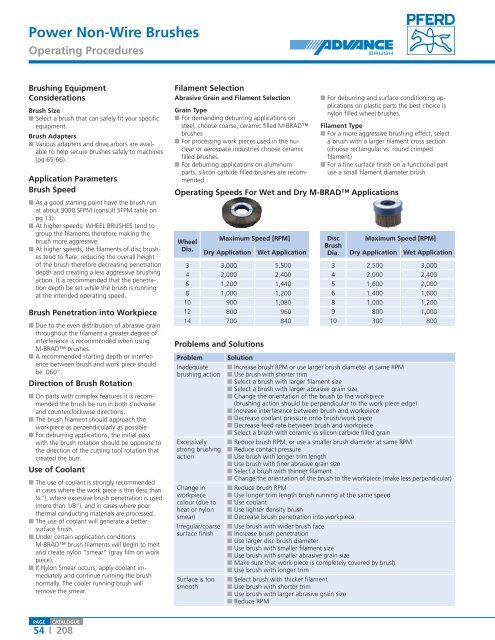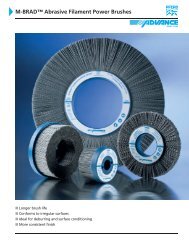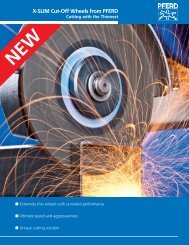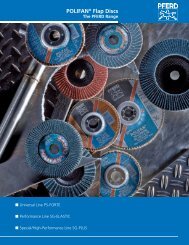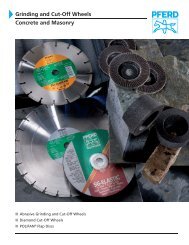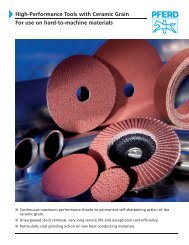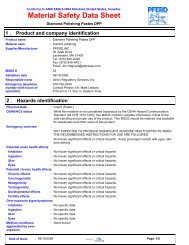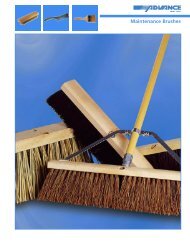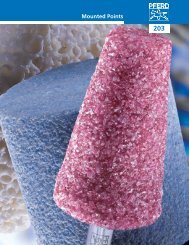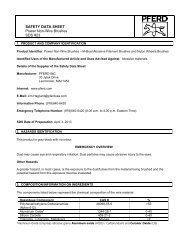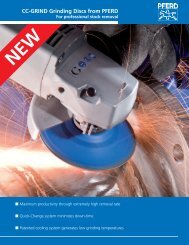Power Wire Brushes - Pferd
Power Wire Brushes - Pferd
Power Wire Brushes - Pferd
Create successful ePaper yourself
Turn your PDF publications into a flip-book with our unique Google optimized e-Paper software.
<strong>Power</strong> Non-<strong>Wire</strong> <strong>Brushes</strong><br />
Operating Procedures<br />
Brushing Equipment<br />
Considerations<br />
Brush Size<br />
■■Select a brush that can safely fit your specific<br />
equipment.<br />
Brush Adapters<br />
■■Various adapters and drive arbors are available<br />
to help secure brushes safely to machines<br />
(pg 65-66).<br />
Application Parameters<br />
Brush Speed<br />
■■As a good starting point have the brush run<br />
at about 3000 SFPM (consult SFPM table on<br />
pg 13).<br />
■■At higher speeds, WHEEL BRUSHES tend to<br />
group the filaments therefore making the<br />
brush more aggressive.<br />
■■At higher speeds, the filaments of disc brushes<br />
tend to flare, reducing the overall height<br />
of the brush therefore decreasing penetration<br />
depth and creating a less aggressive brushing<br />
action. It is recommended that the penetration<br />
depth be set while the brush is running<br />
at the intended operating speed.<br />
Brush Penetration into Workpiece<br />
■■Due to the even distribution of abrasive grain<br />
throughout the filament a greater degree of<br />
interference is recommended when using<br />
M-BRAD brushes.<br />
■■A recommended starting depth or interference<br />
between brush and work piece should<br />
be .060”.<br />
Direction of Brush Rotation<br />
■■On parts with complex features it is recommended<br />
the brush be run in both clockwise<br />
and counterclockwise directions.<br />
■■The brush filament should approach the<br />
workpiece as perpendicularly as possible<br />
■■For deburring applications, the initial pass<br />
with the brush rotation should be opposite to<br />
the direction of the cutting tool rotation that<br />
created the burr.<br />
Use of Coolant<br />
■■The use of coolant is strongly recommended<br />
in cases where the work piece is thin (less than<br />
¼”), where excessive brush penetration is used<br />
(more than 1/8”), and in cases where poor<br />
thermal conducting materials are processed.<br />
■■The use of coolant will generate a better<br />
surface finish.<br />
■■Under certain application conditions<br />
M-BRAD brush filaments will begin to melt<br />
and create nylon “smear” (gray film on work<br />
piece).<br />
■■If Nylon Smear occurs, apply coolant immediately<br />
and continue running the brush<br />
normally. The cooler running brush will<br />
remove the smear.<br />
Filament Selection<br />
Abrasive Grain and Filament Selection<br />
Grain Type<br />
■■For demanding deburring applications on<br />
steel, choose coarse, ceramic filled M-BRAD<br />
brushes<br />
■■For processing work pieces used in the nuclear<br />
or aerospace industries choose ceramic<br />
filled brushes.<br />
■■For deburring applications on aluminum<br />
parts, silicon carbide filled brushes are recommended<br />
Problems and Solutions<br />
Problem<br />
Inadequate<br />
brushing action<br />
Excessively<br />
strong brushing<br />
action<br />
Change in<br />
workpiece<br />
colour (due to<br />
heat or nylon<br />
smear)<br />
Irregular/coarse<br />
surface finish<br />
Surface is too<br />
smooth<br />
■■For deburring and surface conditioning applications<br />
on plastic parts the best choice is<br />
nylon filled wheel brushes.<br />
Filament Type<br />
■■For a more aggressive brushing effect, select<br />
a brush with a larger filament cross section<br />
(choose rectangular vs. round crimped<br />
filament)<br />
■■For a fine surface finish on a functional part<br />
use a small filament diameter brush<br />
Operating Speeds For Wet and Dry M-BRAD Applications<br />
Wheel<br />
Dia.<br />
Maximum Speed [RPM]<br />
Dry Application<br />
Wet Application<br />
3 3,000 5,500<br />
4 2,000 2,400<br />
6 1,200 1,440<br />
8 1,000 1,200<br />
10 900 1,080<br />
12 800 960<br />
14 700 840<br />
Disc<br />
Brush<br />
Dia.<br />
Maximum Speed [RPM]<br />
Dry Application<br />
Wet Application<br />
3 2,500 3,000<br />
4 2,000 2,400<br />
5 1,600 2,000<br />
6 1,400 1,600<br />
8 1,000 1,200<br />
9 800 1,000<br />
10 300 800<br />
Solution<br />
■■Increase brush RPM or use larger brush diameter at same RPM<br />
■■Use brush with shorter trim<br />
■■Select a brush with larger filament size<br />
■■Select a brush with larger abrasive grain size<br />
■■Change the orientation of the brush to the workpiece<br />
(brushing action should be perpendicular to the work piece edge)<br />
■■Increase interference between brush and workpiece<br />
■■Decrease coolant pressure onto brush/work piece<br />
■■Decrease feed rate between brush and workpiece<br />
■■Select a brush with ceramic vs silicon carbide filled grain<br />
■■Reduce brush RPM, or use a smaller brush diameter at same RPM<br />
■■Reduce contact pressure<br />
■■Use brush with longer trim length<br />
■■Use brush with finer abrasive grain size<br />
■■Select a brush with thinner filament<br />
■■Change the orientation of the brush to the workpiece (make less perpendicular)<br />
■■Reduce brush RPM<br />
■■Use longer trim length brush running at the same speed<br />
■■Use coolant<br />
■■Use lighter density brush<br />
■■Decrease brush penetration into workpiece<br />
■■Use brush with wider brush face<br />
■■Increase brush penetration<br />
■■Use larger disc brush diameter<br />
■■Use brush with smaller filament size<br />
■■Use brush with smaller abrasive grain size<br />
■■Make sure that work piece is completely covered by brush<br />
■■Use brush with longer trim<br />
■■Select brush with thicker filament<br />
■■Use brush with shorter trim<br />
■■Use brush with larger abrasive grain size<br />
■■Reduce RPM<br />
PAGE<br />
CATALOGUE<br />
54 I 208


